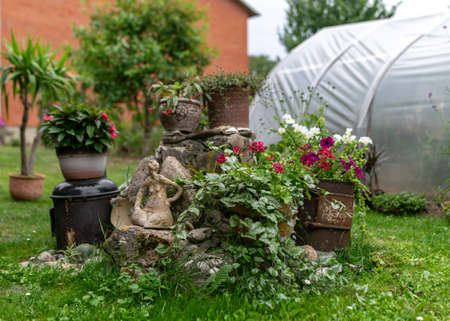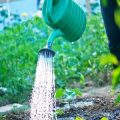Understanding Aphids in British Gardens
Aphids are a frequent and troublesome pest for gardeners across the UK. These tiny insects, often referred to as greenfly or blackfly depending on their species, can quickly colonise a wide range of ornamental and edible plants. Among the most common aphid species found in British gardens are the Green Peach Aphid (Myzus persicae), Black Bean Aphid (Aphis fabae), and the Rose Aphid (Macrosiphum rosae). Each of these species has its preferred host plants, but all share similar feeding habits that can cause significant damage. Gardeners typically notice an infestation when they spot clusters of soft-bodied insects on young shoots, flower buds, or the undersides of leaves. Other tell-tale signs include distorted growth, yellowing leaves, and a sticky residue known as honeydew, which aphids excrete as they feed. This honeydew not only attracts ants but also encourages the growth of sooty mould, further impacting plant health and appearance. Left unchecked, aphid populations can weaken plants by draining sap and transmitting viruses, resulting in stunted growth or poor yields in fruit and vegetable crops. Recognising these early indicators is essential for effective control and for maintaining healthy British gardens.
2. Why Choose Natural Solutions?
When it comes to managing aphids in British gardens, opting for homemade, eco-friendly sprays offers a range of advantages over chemical alternatives. In the context of the UK’s stringent environmental standards and a growing collective consciousness about sustainability, natural methods are increasingly favoured by gardeners who wish to safeguard their local ecosystems as well as their own health.
The Benefits of Homemade, Eco-Friendly Sprays
Homemade solutions typically use readily available household ingredients such as soap, garlic, or neem oil. These components are not only effective against aphids but also pose minimal risk to beneficial insects like ladybirds and bees—a crucial consideration given the UKs efforts to promote pollinator populations. By steering clear of synthetic chemicals, gardeners can reduce soil and water contamination while supporting wildlife diversity.
Comparison: Natural vs Chemical Aphid Control
| Aspect | Homemade/Natural Sprays | Chemical Sprays |
|---|---|---|
| Environmental Impact | Low; biodegradable and safe for most non-target species | High; may contaminate soil and waterways, harm beneficial insects |
| Health Risks | Minimal; generally non-toxic to humans and pets when used correctly | Potentially hazardous; require careful handling and protective equipment |
| Cost & Accessibility | Inexpensive; made from common household items | Can be costly; regular purchases required from garden centres |
| Regulatory Compliance (UK) | Easily aligns with organic gardening standards and local regulations | Subject to restrictions and guidance under UK pesticide regulations |
| Effect on Garden Ecosystem | Supports biodiversity and healthy soil microflora | May disrupt ecosystem balance if overused or misapplied |
Sustainable Gardening in the British Context
The shift towards natural pest control reflects broader trends in British horticulture, where sustainability is a core value. By choosing homemade sprays, gardeners contribute positively to their local environment, comply with UK guidelines for responsible pesticide use, and foster a culture of environmental stewardship for future generations.

3. Essential Ingredients for Homemade Aphid Sprays
When tackling aphids in British gardens, the effectiveness of homemade sprays often relies on accessible household items and locally sourced ingredients. Here’s a structured breakdown of key components you can use to create natural, affordable, and environmentally friendly solutions.
Washing-Up Liquid
This staple in most British homes is more than just a cleaning agent; diluted washing-up liquid forms the base of many DIY aphid sprays. Its gentle action breaks down the protective coating on aphids, causing them to dehydrate without harming most plants when used correctly.
How to Use:
Add a few drops (about a teaspoon) of mild, unscented washing-up liquid to a litre of water. Mix gently and spray directly onto affected leaves, ensuring thorough coverage on both sides.
White Vinegar
A common pantry item, white vinegar offers mild acidity that can deter aphids. It should be used sparingly as excessive application may harm sensitive plants.
How to Use:
Combine one part white vinegar with ten parts water. Test the spray on a small section of your plant before wider application to ensure no leaf damage occurs.
Neem Oil
Although not native, neem oil is widely available in UK garden centres and is valued for its natural pest-repelling qualities. It interrupts aphid feeding and reproduction cycles, making it a powerful addition to any homemade remedy.
How to Use:
Mix 1-2 teaspoons of neem oil with a litre of water and add a drop of washing-up liquid to help emulsify the solution. Shake well before spraying onto infested plants.
Garlic and Chilli Infusions
Garlic cloves and fresh chillies are readily available from local markets or allotments across Britain. Their strong scents and compounds act as natural deterrents against aphids and other soft-bodied pests.
How to Use:
Mash or finely chop several garlic cloves or chillies, steep them in boiling water overnight, strain the mixture, and dilute it further with water before applying as a foliar spray.
Bicarbonate of Soda (Baking Soda)
A familiar item in British baking cupboards, bicarbonate of soda can help prevent fungal issues that sometimes follow aphid infestations. While not directly lethal to aphids, it supports overall plant health when included in sprays.
How to Use:
Dissolve half a teaspoon in a litre of water along with a drop of washing-up liquid for an all-round preventative spray.
By leveraging these everyday ingredients—many sourced from your own kitchen or local shops—you can create effective, sustainable sprays tailored for British gardens. This approach not only keeps aphid populations under control but also aligns with eco-friendly gardening practices cherished throughout the UK.
4. Step-by-Step Homemade Aphid Spray Recipes
Creating your own aphid sprays at home is both cost-effective and environmentally friendly, especially when tailored to the specific needs of British gardens. Below, youll find detailed recipes using everyday household ingredients, all measured in metric units for accuracy. Follow these step-by-step instructions to mix, apply, and maximise effectiveness against aphids while protecting beneficial insects and local flora.
Essential Equipment & Ingredients
| Item | Purpose |
|---|---|
| 1-litre spray bottle | Application of solution |
| Measuring jug (metric) | Accurate measurement of liquids |
| Soft water (tap or rainwater) | Main ingredient for dilution |
| Mild liquid soap (unscented) | Aphid removal agent |
| Bicarbonate of soda or garlic cloves (optional) | Additional natural pest deterrents |
| Kettle or saucepan (if using garlic) | Preparation of garlic infusion |
Recipe 1: Classic Soap Spray
- Add 1 litre of soft water to your spray bottle.
- Add 1–2 teaspoons (5–10 ml) of unscented liquid soap.
- Screw on the lid and gently swirl to combine – avoid shaking vigorously as this may cause excessive foaming.
- Test-spray a small section of the plant. If there is no damage after 24 hours, proceed to treat affected areas thoroughly, especially the undersides of leaves where aphids cluster.
- Apply every 3–5 days until infestation subsides.
Tip:
If you have hard water, opt for rainwater to avoid residue build-up on leaves common in many UK regions.
Recipe 2: Garlic Infusion Spray
- Crush 2–3 large garlic cloves and place them in a heatproof bowl.
- Pour 500 ml of boiling water over the garlic and let steep for 12 hours.
- Strain the mixture into a jug, then top up with cold water to make a total of 1 litre.
- Add 1 teaspoon (5 ml) of mild liquid soap to help the solution adhere to leaves.
- Transfer to a spray bottle and apply directly onto affected plants once weekly during peak aphid season.
Cautions & Best Practices:
- Avoid spraying during hot midday sun; early morning or evening applications are preferable for most British climates.
- Always test on a small area before full application, as some delicate ornamentals may be sensitive even to mild soaps.
- Reapply after heavy rain or overhead watering.
Troubleshooting Table: Common Issues & Solutions
| Issue Observed | Likely Cause | Recommended Action |
|---|---|---|
| Leaf scorching or yellowing after application | Spray too concentrated or applied in direct sunlight | Dilute mixture further and spray during cooler periods of the day |
| No effect on aphid population after several treatments | Aphids resistant or improper coverage | Ensure thorough coverage and alternate between soap and garlic sprays if needed |
By following these clear, metric-based recipes and practical guidance, you can confidently manage aphid infestations in your British garden without resorting to harsh chemicals—supporting both plant health and local biodiversity.
5. Best Practices for Application in the UK Climate
The success of homemade aphid sprays in British gardens relies heavily on understanding when and how to apply them, particularly given the country’s famously unpredictable weather. Here are some key guidelines tailored to maximise effectiveness while safeguarding both your plants and the local environment.
Timing Your Application
Early Morning or Late Afternoon: For optimal results, apply natural sprays either in the early morning or late afternoon. These cooler periods minimise the risk of leaf scorch and allow the solution to linger longer before evaporating.
Avoid Wet Weather
British rain can quickly wash away any treatment, reducing efficacy. Check the forecast before spraying—choose a dry day with at least 24 hours of clear weather ahead. If showers are expected, postpone application until conditions improve.
Temperature Considerations
Most homemade solutions perform best between 10°C and 20°C. Extremely hot or cold spells—though rare—can stress plants and diminish the effectiveness of sprays. Monitor local temperatures and adjust your schedule accordingly.
Application Techniques
Thorough Coverage: Aphids often hide on the undersides of leaves and along stems. Use a fine mist sprayer to ensure even coverage without over-saturating the plant. Pay special attention to vulnerable new growth where infestations typically begin.
Frequency of Spraying
Repeat applications every 5–7 days during an active infestation, or after heavy rain, to maintain protection. After two to three successful treatments, reassess for aphid activity before continuing.
Environmental Responsibility
Avoid applying homemade sprays during windy conditions, as drift can affect neighbouring plants or beneficial insects such as ladybirds and bees. Always test a small area first, especially if you’re using a new recipe, to check for any adverse reactions.
Record-Keeping
Keep a simple garden journal noting dates of application and weather conditions; this helps refine your approach year-on-year, adapting to Britain’s changeable climate for consistently healthy, aphid-free plants.
6. Safety Tips and Considerations
When using homemade sprays to control aphids in your British garden, it is essential to prioritise the safety of pets, local wildlife, and beneficial insects such as bees and ladybirds. While natural solutions are generally less hazardous than chemical pesticides, their improper use can still pose risks. Here are some key guidelines to ensure safe and responsible application:
Choose Ingredients Carefully
Opt for ingredients that are proven safe for non-target species. Avoid substances with strong residual effects or those known to harm pollinators. For example, while garlic and soap sprays are effective against aphids, ensure soaps used are biodegradable and free from harsh chemicals.
Apply at the Right Time
Timing your applications can significantly reduce unintended impact. Spray in the early morning or late evening when pollinators are less active. This minimises direct exposure to bees and other beneficial insects during peak activity periods.
Protect Water Sources
Avoid spraying near ponds, streams, or birdbaths to prevent contamination that could affect aquatic life or drinking water for pets and wildlife. Always check the weather forecast; never spray before heavy rain, as runoff can carry residues into sensitive areas.
Monitor for Beneficial Insects
Before treating plants, inspect for natural predators like ladybirds or lacewing larvae already feeding on aphids. If present, consider leaving the area untreated or using spot applications rather than blanket coverage.
Store Solutions Safely
Keep homemade sprays out of reach of children and animals. Label bottles clearly and store them in a cool, dry place away from pet food or garden produce.
Responsible Disposal
If you have leftover spray solution, dispose of it responsibly by pouring it onto bare soil away from water sources or compost heaps. Never pour unused mixtures down household drains.
Regularly Review Your Approach
Observe the effects after each application and adjust your methods if you notice any negative impact on garden biodiversity. The goal is to balance effective aphid management with the preservation of a healthy ecosystem in your British garden.
7. Community Experiences and Advice
British gardeners have long relied on their ingenuity and a sense of community to tackle common garden pests like aphids. Drawing from allotment groups, gardening clubs, and online forums, many have shared their tried-and-tested methods for natural aphid control—demonstrating that homemade solutions can be both effective and environmentally friendly.
Insights from British Gardeners
Many seasoned gardeners swear by a simple garlic spray as an effective deterrent. According to members of the Royal Horticultural Society’s forums, steeping crushed garlic in water overnight and straining the mixture before applying with a spray bottle can keep aphid populations in check without harming beneficial insects. Some recommend adding a few drops of mild washing-up liquid to help the spray adhere to leaves.
Practical Tips for Success
- Consistency is Key: Multiple gardeners advise regular application, especially after rainfall, to maintain protection throughout the growing season.
- Spot Testing: Before treating all your plants, test homemade sprays on a small area first to ensure they do not cause leaf burn or other adverse effects.
- Early Intervention: The consensus among experienced growers is to act at the first sign of aphids, as natural remedies are most effective when infestations are caught early.
Learning from Local Experience
Community gardens across the UK have also found success using homemade nettle or rhubarb leaf infusions. These not only deter aphids but also provide a sustainable use for otherwise discarded plant material. Sharing recipes and results at local gardening events has fostered a culture of collaboration and ongoing improvement.
Ultimately, British gardeners highlight the importance of observation, persistence, and sharing knowledge within the community. By leveraging collective wisdom and eco-friendly solutions, it is possible to protect your garden from aphids while maintaining harmony with nature.


